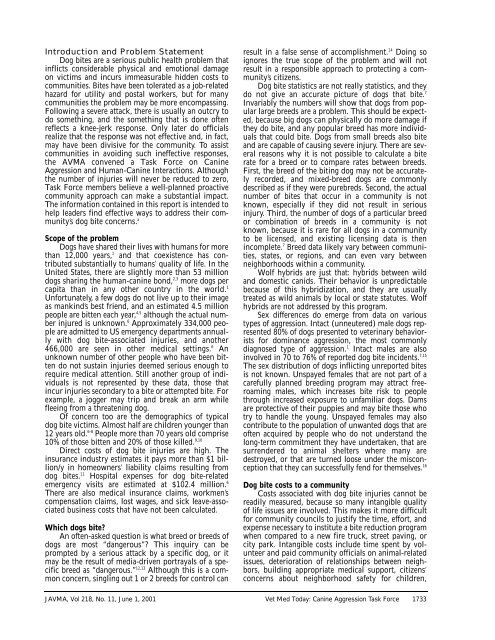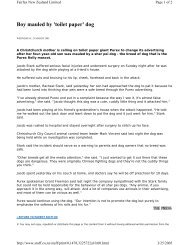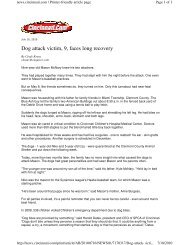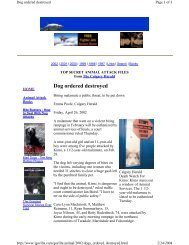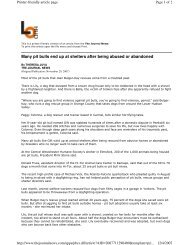A community approach to dog bite prevention - American Veterinary ...
A community approach to dog bite prevention - American Veterinary ...
A community approach to dog bite prevention - American Veterinary ...
You also want an ePaper? Increase the reach of your titles
YUMPU automatically turns print PDFs into web optimized ePapers that Google loves.
Introduction and Problem Statement<br />
Dog <strong>bite</strong>s are a serious public health problem that<br />
inflicts considerable physical and emotional damage<br />
on victims and incurs immeasurable hidden costs <strong>to</strong><br />
communities. Bites have been <strong>to</strong>lerated as a job-related<br />
hazard for utility and postal workers, but for many<br />
communities the problem may be more encompassing.<br />
Following a severe attack, there is usually an outcry <strong>to</strong><br />
do something, and the something that is done often<br />
reflects a knee-jerk response. Only later do officials<br />
realize that the response was not effective and, in fact,<br />
may have been divisive for the <strong>community</strong>. To assist<br />
communities in avoiding such ineffective responses,<br />
the AVMA convened a Task Force on Canine<br />
Aggression and Human-Canine Interactions. Although<br />
the number of injuries will never be reduced <strong>to</strong> zero,<br />
Task Force members believe a well-planned proactive<br />
<strong>community</strong> <strong>approach</strong> can make a substantial impact.<br />
The information contained in this report is intended <strong>to</strong><br />
help leaders find effective ways <strong>to</strong> address their <strong>community</strong>’s<br />
<strong>dog</strong> <strong>bite</strong> concerns. a<br />
Scope of the problem<br />
Dogs have shared their lives with humans for more<br />
than 12,000 years, 1 and that coexistence has contributed<br />
substantially <strong>to</strong> humans’ quality of life. In the<br />
United States, there are slightly more than 53 million<br />
<strong>dog</strong>s sharing the human-canine bond, 2,3 more <strong>dog</strong>s per<br />
capita than in any other country in the world. 1<br />
Unfortunately, a few <strong>dog</strong>s do not live up <strong>to</strong> their image<br />
as mankind’s best friend, and an estimated 4.5 million<br />
people are bitten each year, 4,5 although the actual number<br />
injured is unknown. 6 Approximately 334,000 people<br />
are admitted <strong>to</strong> US emergency departments annually<br />
with <strong>dog</strong> <strong>bite</strong>-associated injuries, and another<br />
466,000 are seen in other medical settings. 6 An<br />
unknown number of other people who have been bitten<br />
do not sustain injuries deemed serious enough <strong>to</strong><br />
require medical attention. Still another group of individuals<br />
is not represented by these data, those that<br />
incur injuries secondary <strong>to</strong> a <strong>bite</strong> or attempted <strong>bite</strong>. For<br />
example, a jogger may trip and break an arm while<br />
fleeing from a threatening <strong>dog</strong>.<br />
Of concern <strong>to</strong>o are the demographics of typical<br />
<strong>dog</strong> <strong>bite</strong> victims. Almost half are children younger than<br />
12 years old. 6-8 People more than 70 years old comprise<br />
10% of those bitten and 20% of those killed. 9,10<br />
Direct costs of <strong>dog</strong> <strong>bite</strong> injuries are high. The<br />
insurance industry estimates it pays more than $1 billion/y<br />
in homeowners’ liability claims resulting from<br />
<strong>dog</strong> <strong>bite</strong>s. 11 Hospital expenses for <strong>dog</strong> <strong>bite</strong>-related<br />
emergency visits are estimated at $102.4 million. 6<br />
There are also medical insurance claims, workmen’s<br />
compensation claims, lost wages, and sick leave-associated<br />
business costs that have not been calculated.<br />
Which <strong>dog</strong>s <strong>bite</strong>?<br />
An often-asked question is what breed or breeds of<br />
<strong>dog</strong>s are most “dangerous”? This inquiry can be<br />
prompted by a serious attack by a specific <strong>dog</strong>, or it<br />
may be the result of media-driven portrayals of a specific<br />
breed as “dangerous.” 12,13 Although this is a common<br />
concern, singling out 1 or 2 breeds for control can<br />
result in a false sense of accomplishment. 14 Doing so<br />
ignores the true scope of the problem and will not<br />
result in a responsible <strong>approach</strong> <strong>to</strong> protecting a <strong>community</strong>’s<br />
citizens.<br />
Dog <strong>bite</strong> statistics are not really statistics, and they<br />
do not give an accurate picture of <strong>dog</strong>s that <strong>bite</strong>. 7<br />
Invariably the numbers will show that <strong>dog</strong>s from popular<br />
large breeds are a problem. This should be expected,<br />
because big <strong>dog</strong>s can physically do more damage if<br />
they do <strong>bite</strong>, and any popular breed has more individuals<br />
that could <strong>bite</strong>. Dogs from small breeds also <strong>bite</strong><br />
and are capable of causing severe injury. There are several<br />
reasons why it is not possible <strong>to</strong> calculate a <strong>bite</strong><br />
rate for a breed or <strong>to</strong> compare rates between breeds.<br />
First, the breed of the biting <strong>dog</strong> may not be accurately<br />
recorded, and mixed-breed <strong>dog</strong>s are commonly<br />
described as if they were purebreds. Second, the actual<br />
number of <strong>bite</strong>s that occur in a <strong>community</strong> is not<br />
known, especially if they did not result in serious<br />
injury. Third, the number of <strong>dog</strong>s of a particular breed<br />
or combination of breeds in a <strong>community</strong> is not<br />
known, because it is rare for all <strong>dog</strong>s in a <strong>community</strong><br />
<strong>to</strong> be licensed, and existing licensing data is then<br />
incomplete. 7 Breed data likely vary between communities,<br />
states, or regions, and can even vary between<br />
neighborhoods within a <strong>community</strong>.<br />
Wolf hybrids are just that: hybrids between wild<br />
and domestic canids. Their behavior is unpredictable<br />
because of this hybridization, and they are usually<br />
treated as wild animals by local or state statutes. Wolf<br />
hybrids are not addressed by this program.<br />
Sex differences do emerge from data on various<br />
types of aggression. Intact (unneutered) male <strong>dog</strong>s represented<br />
80% of <strong>dog</strong>s presented <strong>to</strong> veterinary behaviorists<br />
for dominance aggression, the most commonly<br />
diagnosed type of aggression. 1 Intact males are also<br />
involved in 70 <strong>to</strong> 76% of reported <strong>dog</strong> <strong>bite</strong> incidents. 7,15<br />
The sex distribution of <strong>dog</strong>s inflicting unreported <strong>bite</strong>s<br />
is not known. Unspayed females that are not part of a<br />
carefully planned breeding program may attract freeroaming<br />
males, which increases <strong>bite</strong> risk <strong>to</strong> people<br />
through increased exposure <strong>to</strong> unfamiliar <strong>dog</strong>s. Dams<br />
are protective of their puppies and may <strong>bite</strong> those who<br />
try <strong>to</strong> handle the young. Unspayed females may also<br />
contribute <strong>to</strong> the population of unwanted <strong>dog</strong>s that are<br />
often acquired by people who do not understand the<br />
long-term commitment they have undertaken, that are<br />
surrendered <strong>to</strong> animal shelters where many are<br />
destroyed, or that are turned loose under the misconception<br />
that they can successfully fend for themselves. 16<br />
Dog <strong>bite</strong> costs <strong>to</strong> a <strong>community</strong><br />
Costs associated with <strong>dog</strong> <strong>bite</strong> injuries cannot be<br />
readily measured, because so many intangible quality<br />
of life issues are involved. This makes it more difficult<br />
for <strong>community</strong> councils <strong>to</strong> justify the time, effort, and<br />
expense necessary <strong>to</strong> institute a <strong>bite</strong> reduction program<br />
when compared <strong>to</strong> a new fire truck, street paving, or<br />
city park. Intangible costs include time spent by volunteer<br />
and paid <strong>community</strong> officials on animal-related<br />
issues, deterioration of relationships between neighbors,<br />
building appropriate medical support, citizens’<br />
concerns about neighborhood safety for children,<br />
JAVMA, Vol 218, No. 11, June 1, 2001 Vet Med Today: Canine Aggression Task Force 1733


